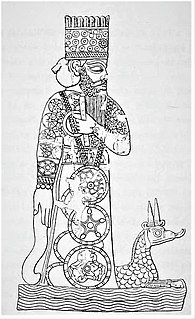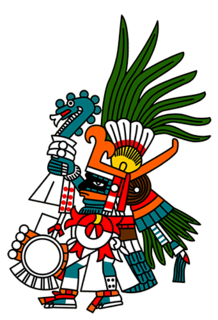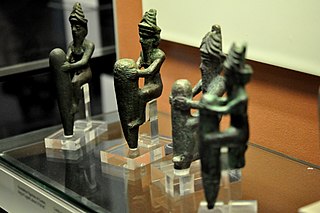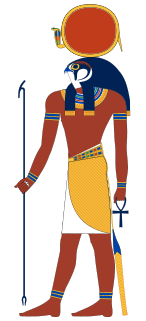Related Research Articles

Hades, in the ancient Greek religion and myth, is the god of the dead and the king of the underworld, with which his name became synonymous. Hades was the eldest son of Cronus and Rhea, although the last son regurgitated by his father. He and his brothers, Zeus and Poseidon, defeated their father's generation of gods, the Titans, and claimed rulership over the cosmos. Hades received the underworld, Zeus the sky, and Poseidon the sea, with the solid earth, long the province of Gaia, available to all three concurrently. Hades was often portrayed with his three-headed guard dog Cerberus.

A solar deity is a sky deity who represents the Sun, or an aspect of it, usually by its perceived power and strength. Solar deities and Sun worship can be found throughout most of recorded history in various forms. The Sun is sometimes referred to by its Latin name Sol or by its Greek name Helios. The English word sun stems from Proto-Germanic *sunnǭ.

Tlaloc is a member of the pantheon of gods in Aztec religion. As supreme god of the rain, Tlaloc is also a god of earthly fertility and of water. He was widely worshipped as a beneficent giver of life and sustenance. However, he was also feared for his ability to send hail, thunder, and lightning, and for being the lord of the powerful element of water. Tlaloc is also associated with caves, springs, and mountains, most specifically the sacred mountain in which he was believed to reside. His animal forms include herons and water-dwelling creatures such as amphibians, snails, and possibly sea creatures, particularly shellfish. The Mexican marigold, Tagetes lucida, known to the Aztecs as yauhtli, was another important symbol of the god, and was burned as a ritual incense in native religious ceremonies.

Varuna is a Vedic deity associated initially with the sky, later also with the seas as well as Ṛta (justice) and Satya (truth). He is found in the oldest layer of Vedic literature of Hinduism, such as hymn 7.86 of the Rigveda. He is also mentioned in the Tamil grammar work Tolkāppiyam, as the god of sea and rain. He is said to be the son of Kashyapa.

Yahweh was the national god of the kingdoms of Israel (Samaria) and Judah, with origins reaching at least to the early Iron Age and apparently to the Late Bronze Age. In the oldest biblical literature he is a storm-and-warrior deity who leads the heavenly army against Israel's enemies; at that time the Israelites worshipped him alongside a variety of Canaanite gods and goddesses, including El, Asherah and Baal, but in later centuries El and Yahweh became conflated and El-linked epithets such as El Shaddai came to be applied to Yahweh alone, and other gods and goddesses such as Baal and Asherah were absorbed into the Yahwistic religion.

Horus or Her, Heru, Hor, Har in Ancient Egyptian, is one of the most significant ancient Egyptian deities who served many functions, most notably god of kingship and the sky. He was worshipped from at least the late prehistoric Egypt until the Ptolemaic Kingdom and Roman Egypt. Different forms of Horus are recorded in history and these are treated as distinct gods by Egyptologists. These various forms may possibly be different manifestations of the same multi-layered deity in which certain attributes or syncretic relationships are emphasized, not necessarily in opposition but complementary to one another, consistent with how the Ancient Egyptians viewed the multiple facets of reality. He was most often depicted as a falcon, most likely a lanner falcon or peregrine falcon, or as a man with a falcon head.

Baal, properly Baʽal, was a title and honorific meaning "owner", "lord" in the Northwest Semitic languages spoken in the Levant during antiquity. From its use among people, it came to be applied to gods. Scholars previously associated the theonym with solar cults and with a variety of unrelated patron deities, but inscriptions have shown that the name Baʿal was particularly associated with the storm and fertility god Hadad and his local manifestations.

Mesopotamian religion refers to the religious beliefs and practices of the civilizations of ancient Mesopotamia, particularly Sumer, Akkad, Assyria and Babylonia between circa 3500 BC and 400 AD, after which they largely gave way to Syriac Christianity. The religious development of Mesopotamia and Mesopotamian culture in general was not particularly influenced by the movements of the various peoples into and throughout the area, particularly the south. Rather, Mesopotamian religion was a consistent and coherent tradition which adapted to the internal needs of its adherents over millennia of development.

In the Aztec religion, Huitzilopochtli is a deity of war, sun, human sacrifice, and the patron of the city of Tenochtitlan. He was also the national god of the Mexicas, also known as Aztecs, of Tenochtitlan. Many in the pantheon of deities of the Aztecs were inclined to have a fondness for a particular aspect of warfare. However, Huitzilopochtli was known as the primary god of war in ancient Mexico. Since he was the patron god of the Mexica, he was credited with both the victories and defeats that the Mexica people had on the battlefield. The people had to make sacrifices to him to protect the Aztec from infinite night. He wielded Xiuhcoatl as a weapon, associating him with fire.

Indra is an ancient Vedic deity in Hinduism, a guardian deity in Buddhism, and the king of the highest heaven called Saudharmakalpa in Jainism. He is also an important deity worshipped in Kalasha religion, indicating his prominence in ancient Hinduism. Indra's mythology and powers are similar to other Indo-European deities such as Jupiter, Perun, Perkūnas, Zalmoxis, Taranis, Zeus, and Thor, suggesting a common orgin in Proto-Indo-European mythology.

Vayu is a primary Hindu deity, the lord of the winds and the spiritual father of Hanuman and Bhima. He is also known as Anila, Vyāna (air), Vāta, Tanuna, Pavana, and sometimes Prāṇa. According to Rigveda, Vayu is also described as Rudra.

The Anunnaki are a group of deities who appear in the mythological traditions of the ancient Sumerians, Akkadians, Assyrians, and Babylonians. Descriptions of how many Anunnaki there were and what role they fulfilled are inconsistent and often contradictory. In the earliest Sumerian writings about them, which come from the Post-Akkadian period, the Anunnaki are the most powerful deities in the pantheon, descendants of An and Ki, the god of the heavens and the goddess of earth, and their primary function is to decree the fate of Sumerians.

Hittite mythology and Hittite religion were the religious beliefs and practices of the Hittites, who created an empire centered in what is now Turkey from c. 1600 BC to 1180 BC.

Ancient Egyptian deities are the gods and goddesses worshipped in ancient Egypt. The beliefs and rituals surrounding these gods formed the core of ancient Egyptian religion, which emerged sometime in prehistory. Deities represented natural forces and phenomena, and the Egyptians supported and appeased them through offerings and rituals so that these forces would continue to function according to maat, or divine order. After the founding of the Egyptian state around 3100 BC, the authority to perform these tasks was controlled by the pharaoh, who claimed to be the gods' representative and managed the temples where the rituals were carried out.

Quetzalcoatl is a deity in Mesoamerican culture and literature whose name comes from the Nahuatl language and means "Precious serpent" or "Quetzal-feathered Serpent". In the 17th century, Ixtlilxóchitl, a descendant of Aztec royalty and historian of the Nahua people, wrote, "Quetzalcoatl, in its literal sense, means 'serpent of precious feathers', but in the allegorical sense, 'wisest of men'."
Amun was a major ancient Egyptian deity who appears as a member of the Hermopolitan Ogdoad. Amun was attested from the Old Kingdom together with his wife Amaunet. With the 11th Dynasty, Amun rose to the position of patron deity of Thebes by replacing Montu.

Ra or Re is the ancient Egyptian deity of the sun. By the Fifth Dynasty in the 25th and 24th centuries BC, he had become one of the most important gods in ancient Egyptian religion, identified primarily with the noon sun. Ra was believed to rule in all parts of the created world: the sky, the Earth, and the underworld. He was the god of the sun, order, kings, and the sky.

A deity or god is a supernatural being considered divine or sacred. The Oxford Dictionary of English defines deity as "a god or goddess ", or anything revered as divine. C. Scott Littleton defines a deity as "a being with powers greater than those of ordinary humans, but who interacts with humans, positively or negatively, in ways that carry humans to new levels of consciousness, beyond the grounded preoccupations of ordinary life". A goddess is a female deity.
Gohone is an Iroquois deity associated with winter.
References
- ↑ Charles Russell Coulter; Patricia Turner (4 July 2013). Encyclopedia of Ancient Deities. Routledge. p. 15. ISBN 978-1-135-96390-3.
- ↑ Hartley Burr Alexander (7 March 2012). Native American Mythology. Courier Corporation. pp. 25–26. ISBN 978-0-486-12279-3.
- ↑ Mike Dixon-Kennedy (1998). Native American Myth & Legend: An A-Z of People and Places. Brockhampton Press. p. 98. ISBN 978-1-86019-839-7.
| This article relating to a myth or legend from North America is a stub. You can help Wikipedia by expanding it. |
 | This article about a deity is a stub. You can help Wikipedia by expanding it. |